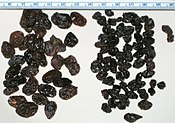Korinthiaki
| Korinthiaki | |
|---|---|
| Synonyms | Black Corinth - for more see the Synonyms section |

|
|
| Art | Grape vine ( Vitis vinifera subsp. Vinifera ) |
| Berry color | black |
| use | |
| origin | Greece |
| VIVC no. | 6410 |
| List of grape varieties | |

Korinthiaki ( German : Black Korinthe, English : Zante currant, Dutch: krent, Latin : Vitis vinifera apyrena ) is a red wine and table grape variety that is cultivated worldwide. The variety takes its name from the place Corinth or from the Ionian island of Zakynthos , which is called "Zante" in Italian.
It is one of the most important table grapes after the Sultana grape variety . The grape variety is mainly used to produce currants . Currants are often used in the kitchen and are used in dishes of North African cuisine such as couscous . In the English-speaking world, the corinth is part of mincemeat and Christmas pudding . In Holland there is krentenbrood and krentenbollen.
Descent, origin
Ancestry and origin are still unclear. The ampelographer Krimbas suspected that the variety Korinthiaki was a mutation of the variety Liatiko . DNA research has shown that this assumption is incorrect.
distribution
The most important producing countries are Greece (44,000 ha ), Turkey (6,000 ha), Iran (10,000 ha), Australia (1,200 ha) and the United States (approx. 1000 ha). In addition, small areas of cultivation are known in Italy , South Africa and Portugal .
Ampelographic varietal characteristics
- The shoot tip is open. It is hairy with white wool and the tips are slightly pink in color. The yellowish young leaves are hairy like a cobweb.
- The medium-sized, thick and dark green leaves are five-lobed and quite deeply indented. The stem bay is open in a V-shape. The blade is bluntly serrated. The teeth are set medium-wide compared to other grape varieties.
- The cylindrical grape is medium to large in size, very slender, shouldered and dense berries. The round berries are very small (the seedless berries are 5 to 8 mm in diameter, the berries with stunted seeds can grow up to 10 mm) and almost black in color. The berries are very juicy and have a thin skin; they are therefore ideal for drying.
Maturity: The grape variety ripens approx. 20 days after the Gutedel and is therefore considered to ripen early in an international comparison. On the Peloponnese peninsula , the harvest begins as early as August.
properties
The vigorous variety sprouts early and brings good yields of around 12,000 kg grapes / ha. This amount results in approx. 3,000 kg currants / ha. It is resistant to downy mildew, but is susceptible to oidium and botrytis. Ripe berries burst after rainfall during the ripening phase of the berries.
The berries are seedless according to a whim of nature or the existing seeds are stunted. Since the use of fertilizer in the 1940s, the proportion of berries with a core portion has increased. This effect was reinforced by the use of growth hormones such as gibberellic acid . If the plant is treated with hormones approx. 7 to 10 days after it has completely bloomed, the proportion of berries with stunted seeds can be minimized.
Synonyms
Aiga Passera, Alga Passera, Aproszemue Fekete, Black Ascalon, Black Corenth, Black Corinth, Black Corinto, Black Currant, Black Currant Grape, Black Current, Black Zante Currant, Corino Nero, Corinth, Corinth Negru, Corinthe Crni, Corinthe Noir, Corinthe Noire, Corinthiaki Staphis, Corinthnoire, Corinthusi Aproszemer, Corinto, Corinto Negro, Corinto Nero, Corinto Preto, Crni Korint, Currant, Currant Grape, Epicier, Kek Meguadan, Korinka Chernaya, Korinthiski Staphia, Korinthia Staphida, Korinthiaida , Korinthusi, Korinthusi Kek, Korinthusi Magnelkueli, Kourenti, Lianoroghi, Lianorogi, Lianroghi, Marine Noir, Marine Noire, Mavri Corinthiaki, Mavri Korinthiaki, Mavri Korinziaki, Mavri Stafida, Mavri Stafis, Panariduruzzi, Miniti-Niuzzi, Passiti-Niuzzi , Passa Staphis, Passaretta Nera, Passarilla, Passarina Di Liparia, Passarina Nera, Passera, Passeretta Nera, Passeretta Senza Vinaccioli, Passerilla, Passerille, Passerina, Passerina Nera, Pas solina, Passolina Minuttida, Passula Di Corinto, Patras Currant, Patras Currant Zante, Patras Current, Piros Korinthusi, Raisin De Corance, Raisin De Corinth, Raisin De Corinthe, Black Corinth, Siyah Korent, Stafida, Stafida Mavro, Stafidamidabelo, Stafidaphelos Mavri, Staphidampelo, Staphidampelos, Staphina, Staphis, Stephidampelos, Tarmarina, Uva Nera Passa Di Corinto, Uva Nera Passera Di Corinto, Uva Passa, Uva Passa Minima, Uva Passa Nera, Uva Passolina Nera Niuriduzzi, Zante, Zante Currant.
See also
Viticulture in Greece , Viticulture in Turkey , Viticulture in Australia , Viticulture in the United States , Viticulture in South Africa , Viticulture in Italy , Viticulture in Portugal .
literature
- Pierre Galet : Dictionnaire encyclopédique des cépages. Hachette, Paris 2000, ISBN 2-01-236331-8 .
- Konstantinos Lazarakis: The Wines of Greece. Beazley, London 2005, ISBN 1-84000-897-0 .
- Jancis Robinson : The Oxford Wine Lexicon. 3rd, completely revised edition. Hallwag, Munich 2007, ISBN 978-3-8338-0691-9 .
Individual evidence
- ↑ Jancis Robinson , Julia Harding, José Vouillamoz : Wine Grapes , 1st edition 2012, Penguin Books, London, ISBN 978-0-06-220636-7 .
- ↑ Hans Ambrosi , Bernd HE Hill, Erika Maul, Erst H. Rühl, Joachim Schmid, Fritz Schuhmann: Color Atlas Rebsorten 3rd Edition, Eugen Ulmer, 2011, ISBN 978-3-8001-5957-4 , p. 147.
- ↑ Hans Ambrosi , Bernd HE Hill, Erika Maul, Erst H. Rühl, Joachim Schmid, Fritz Schuhmann: Color Atlas Rebsorten 3rd Edition, Eugen Ulmer, 2011, ISBN 978-3-8001-5957-4 , p. 147.
- ↑ accessed on June 27, 2016 Korinthiaki in the database Vitis International Variety Catalog of the Institute for Grapevine Breeding Geilweilerhof (English)
